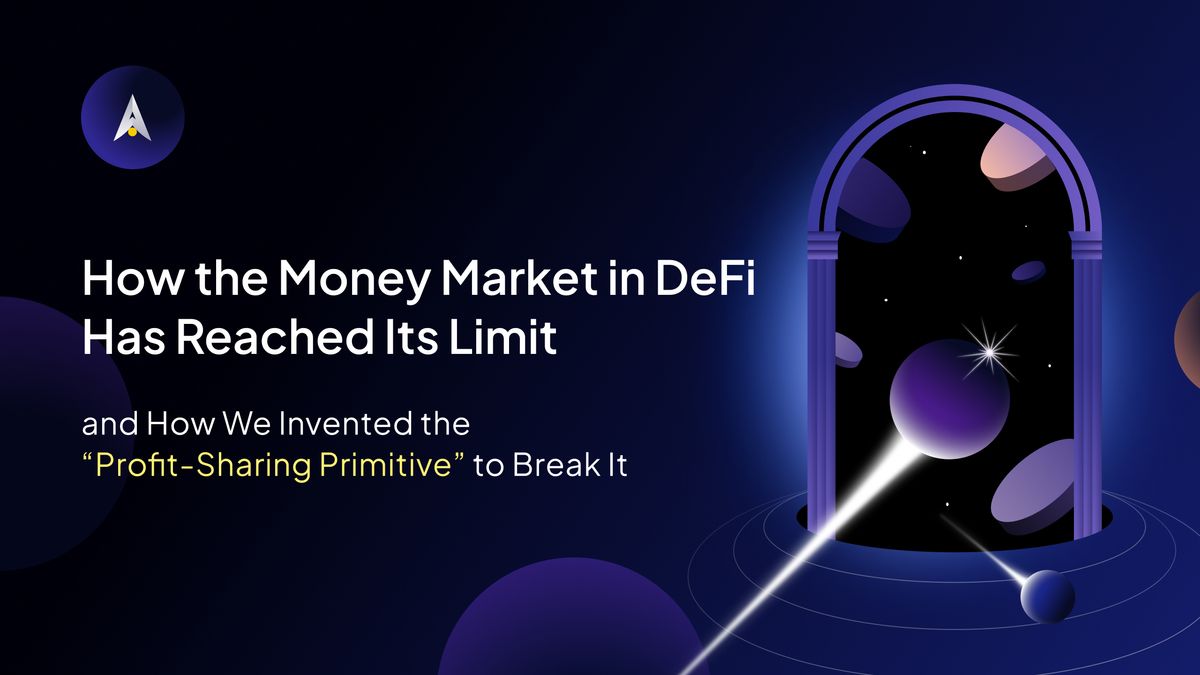How the Money Market in DeFi Has Reached Its Limit, And How We Invented the “Profit-sharing Primitive” to Break It

Money markets are an important part of the DeFi ecosystem, providing a platform for users to lend and borrow digital assets. These lending protocols allow users to earn interest on their deposited assets or borrow assets with collateral, creating a more accessible and efficient financial system. However, despite the many benefits of money markets in DeFi, they face several challenges related to their stability and, most importantly, scalability.
The Biggest Challenge in Money Market and Its Root Cause: Scalability and Interest Rate Model (IRM)
The recent CeFi collapse has pushed institutions to adopt DeFi more than ever, yet the money market cannot scale to accommodate this demand.
The root of the problem lies in the interest rate model (IRM). This model determines the interest rates for lending and borrowing and is utilization rate-based, meaning the interest rate increases as the supply of assets decreases or the demand for assets increases.
When taking a closer look at the metrics in IRM, we see the major problems in how we apply the interest rate model from traditional finance to the protocols in DeFi.
The Demand and Supply in the Interest Rate Model (IRM) Are Ineffective Metrics to Measure the Market’s Need in DeFi
In traditional finance, the interest rates on the money market are set by supply and demand, which are influenced by various factors such as the central bank's monetary policy, inflation, and economic conditions. We all use this interest rate as a benchmark to evaluate the effectiveness of monetary activities.
However, the DeFi ecosystem operates differently. Opportunities are spread out across the ecosystem, and there are no benchmarks to help protocols set up the most optimal IRM that matches the "real demand" from borrowers.
As a result, the IRM on each protocol is disconnected from the ongoing opportunities in the space. It is therefore imperative that we also identify and address the challenges faced by borrowers and lenders in the money market. This approach will help establish a more efficient system that benefits all stakeholders.
Borrowers Are Capped by the Borrowing Interest Rate, Limiting The Ability to Scale The Money Market
One major roadblock that institutions and whales face is the size of their positions, which can cause interest rates to spike and negatively impact returns for users. This makes it difficult for borrowers to predict and manage their returns, particularly when returns are lower than the borrowing interest rates they need to pay.
In a volatile market, borrowers have experienced APR rates as low as -300% from their 9x leveraged positions due to the high borrowing interest rates (30% to 40% APR per 1x) demanded by DeFi protocols.
The borrowers certainly can’t live with this circumstance. It’s crystal clear that we can enhance this pain point.
Lenders Have No Option but to Remain in the "I Get What IRM Gives" Stance, Preventing Their Capital From Reaching Optimal Productivity.
The IRM does not favor lenders in any way. The profit of lenders is completely determined by the utilization rate of their assets. Yet, lenders' capital is regarded as merely a medium for performing liquidity. As a result, lenders have no skin in the game because their incentives for high usage are not correlated with borrowers' activities. In particular, high utilization rates can lead to exorbitant borrowing costs that disincentivize borrowers from engaging in activity. Hence, the best approach to solving this is to align the incentives between borrowers and lenders.
Introducing Profit-Sharing Primitive, the New Liquidity Engine of DeFi
These two factors above make both borrowing and lending unappealing, which discourages institutions from entering DeFi. Hence why we’ve developed a new primitive: the profit-sharing model, a money market infrastructure with security and scalability that aims to disrupt the existing utilization-based IRM. Without IRM and the high borrowing costs, the incentives of borrowers and lenders will become aligned. Borrowers will become intrigued to perform more yield strategies meanwhile lenders will have more skin in the game and yield opportunities.
We’ve incorporated the profit-sharing primitive into our ecosystem through our new upcoming profit-sharing lending protocol, Alpha Chambers, to offer fair and profitable yield opportunities to both lenders and borrowers.
Lenders will be able to lend to leveraged users on Alpha Homora, who will borrow at a 0% interest rate, and a portion of the profit made will be given back to the lenders.
In short, the APY of lenders on Alpha Chambers is determined by the yield generated by Alpha Homora users. As Alpha Homora continues to bring new high-yield strategies to the market, both borrowers and lenders will have the opportunity to enjoy higher yields from the growing DeFi demand.
In the long-term, the Alpha team will expand beyond Alpha Homora to seek for new DeFi protocols to integrate with to ensure we continue to bring the best profitable strategies for users. Our profit-sharing primitive will become the key liquidity source for many DeFi protocols.
Last but not least…
Congratulations on making it to the end! You’re early.
As a token of appreciation for being early to our upcoming profit-sharing narrative, we would like to formally invite you to join our next chapter as Alpha.
On Discord, we are opening an exclusive lounge dedicated to providing you with all the alphas before any public announcement and a space to interact directly with our team.
To get access, all you have to do is claim your role through https://guild.xyz/alpha-venture-dao.
As we begin to finalize the details, you’ll be the first to receive exclusive contents. We look forward to seeing you there. Remember, you’re early and we hope you are as excited as we are!
